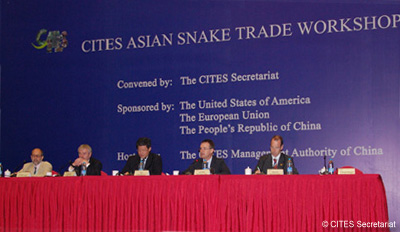For use of the media only;
not an official document.
Guangzhou (China) / Geneva, 18 April 2011 - Better scientific information and closer supervision of captive breeding facilities are crucial for addressing the conservation, sustainability and livelihood aspects of the Asian snake trade.
Those were among the key messages relayed by some 70 experts representing close to 20 governments and international organizations at a workshop in Guangzhou, China, last week.
The event was led by the Convention on International Trade in Endangered Species of Wild Fauna and Flora (CITES) - an international agreement which aims to ensure that trade in wild animals and plants does not threaten their survival.
The workshop followed celebrations held in Beijing last week to mark the 30th anniversary of China joining CITES.
The global trade in snakes involves a variety of species, which are taken from the wild and then bred in captivity. The unsustainable trade of some of these species, as well as the loss of snake habitats, have contributed to a significant decrease in certain populations.
The workshop brought together government experts, members of the CITES Animals Committee and organizations including the International Union for Conservation of Nature (IUCN), the UN Conference on Trade and Development (UNCTAD), the China Wildlife Conservation Association and China Association of Traditional Chinese Medicine. Participants focused primarily on the markets and commercial trade of snakes in East, South, and Southeast Asia.
"I welcome the results of the CITES Asian snake trade workshop which are a very positive step for the conservation and sustainable use of these species", said Carlos Ibero, interim chair of the CITES Animals Committee. "I look forward to detailed discussion of the workshop recommendations at the 25th meeting of the CITES animals committee to be held in Geneva in July", he added.
One third of the 3,315 snake species recognised globally can be found in the regions covered by the workshop. Indonesia is home to 128 endemic snake species, followed by India with 112, China with 54, Papua New Guinea with 42, Sri Lanka with 41, and the Philippines with 32 species. CITES regulates trade in 130 snake species, 45 of which are found in range states in the Asian countries that attended the workshop.
"The global trade in snakes is an industry of considerable socio-economic importance for rural populations in several Asian countries", said Mr John Scanlon, Secretary-General of CITES. "CITES is the main international tool to regulate effectively international snake trade in many of these species. The recommendations coming out of this meeting will be critical in addressing the wildlife conservation, sustainable use and livelihood aspects of such trade, and putting forward expert recommendations to CITES governing bodies for future directions."
"The harvesting of snakes, and in some cases the initial processing of their skins and other body parts, contributes important revenue to local communities in China and neighbouring countries," said Dr Su Chunyu, Executive Director General of the CITES Management Authority of China. "The Chinese Government pays great attention to achieving a harmonious balance between conservation and sustainable use of Asian snakes", he added.
According to a wildlife trade policy review conducted in Viet Nam, the income from snake breeding is three to five times higher than the income generated by vegetable and crop cultivation, and several dozen times higher than the income from pig and cattle breeding.
Snakes play a vital role within their ecosystems. For example, if snakes were to disappear from the rice fields or other crop-producing landscapes of Asia, their prey, left behind with no predator to control their numbers, could have devastating effects on agricultural production, food security and national economies.
Snakes from the forests and jungles of Asia are consumed locally as well as in neighbouring countries for food and traditional medicines. They are also sold as pets and their skins can be found in expensive luxury leather goods and accessories. These skins are often processed in various countries of re-export along the way.
Some examples of Asian snakes in trade (scientific name, common name, major exporters) from the CITES trade database include:
Typical snakes
Ptyas mucosus (Oriental rat snake) - Indonesia (100% of global exports in this species)
Cerberus rhynchops (Dog‐faced water snake) - Indonesia (89%), Thailand (11%)
Pythons
Python breitensteini (Borneo short‐tailed python) Indonesia (70%), Malaysia (30%)
Python brongersmai (Blood python) Malaysia (54%), Indonesia (46%)
Python curtus (Sumatran short‐tailed python) Malaysia (71%), Indonesia (39%)
Python molurus bivittatus (Burmese python)Vietnam (99%)
Python reticulatus (Reticulated python)Malaysia (47%), Indonesia (42%), Vietnam (11%)
Cobras
Naja sputatrix (Indonesian cobra) Indonesia (100%)
Notes to Editors
CITES was adopted in March, 1973, in Washington D.C., following a recommendation of the 1972 United Nations Conference on the Human Environment. It was the first Multilateral Environmental Agreement to enter into force in July 1975 and it assists China and another 174 countries that are Party to CITES to achieve sustainable development through the conservation and sustainable use of biodiversity.
For more information, please contact:
Mr Juan Carlos Vasquez +4179-552 27 32 (mobile), or juan.vasquez@cites.org
See also:
Opening speech of Mr John E. Scanlon, CITES Secretary-General at the CITES Asian Snake Trade Workshop
Press release of 11 April 2011: China hosts crucial meeting on the future of Asian snakes
![]() To read previous press releases, go to Archives.
To read previous press releases, go to Archives.
